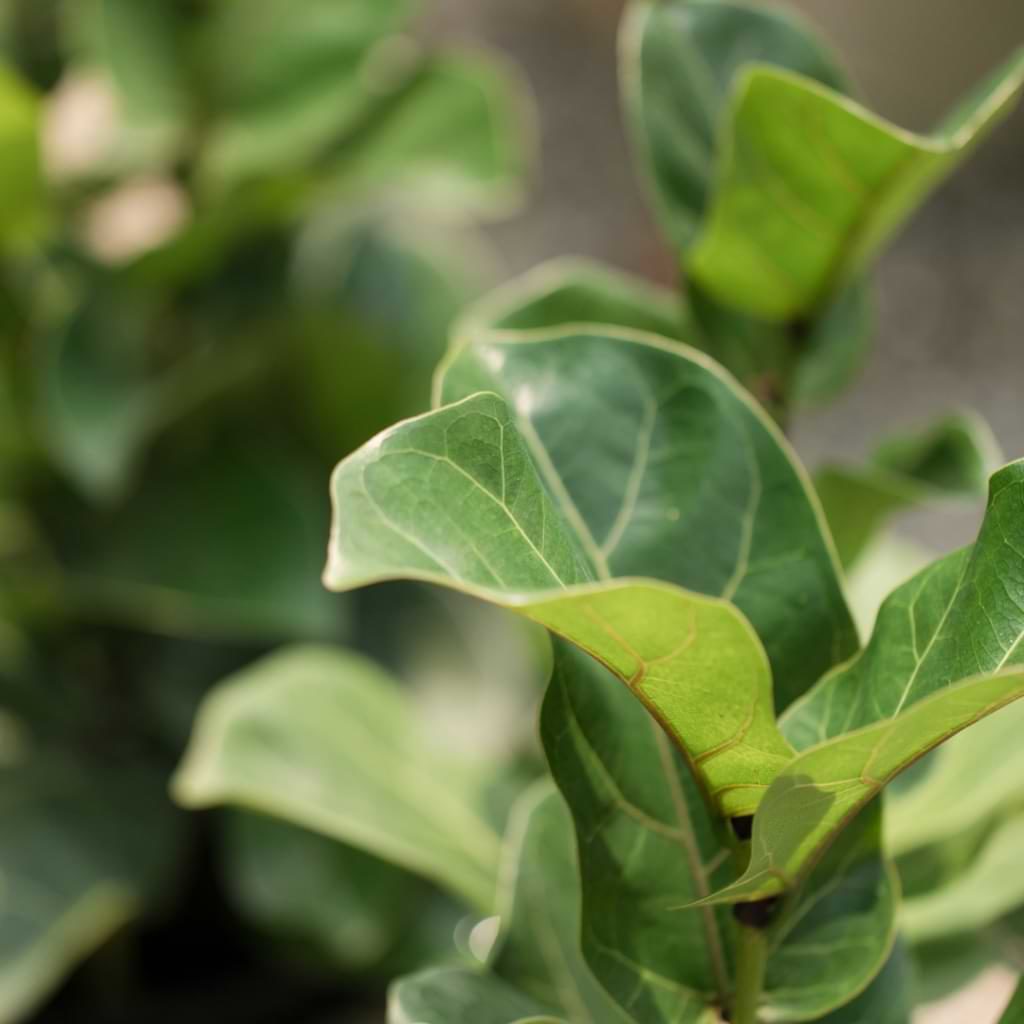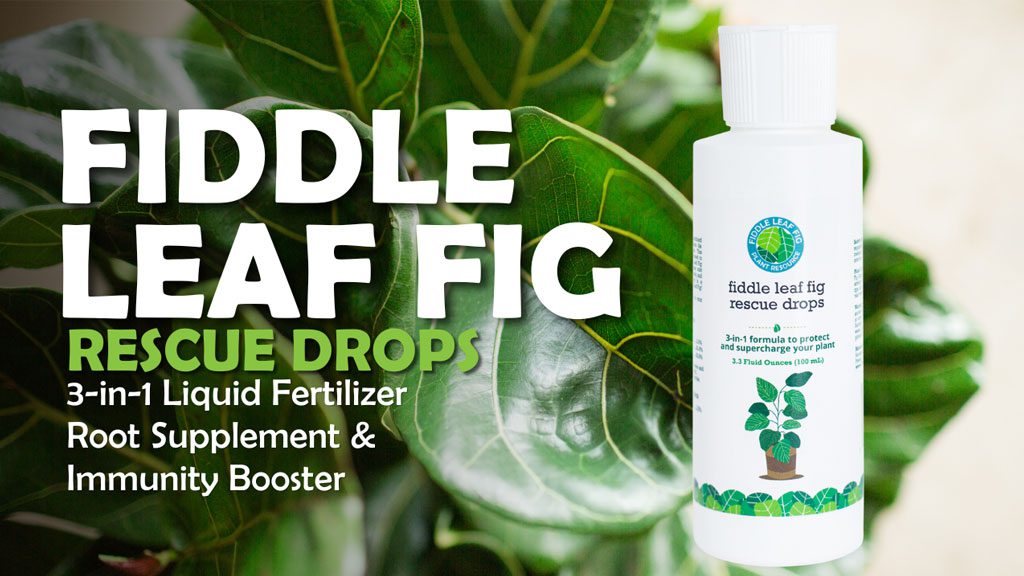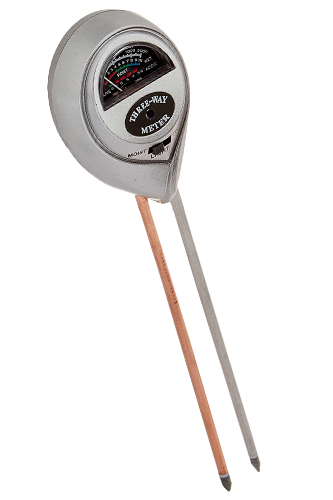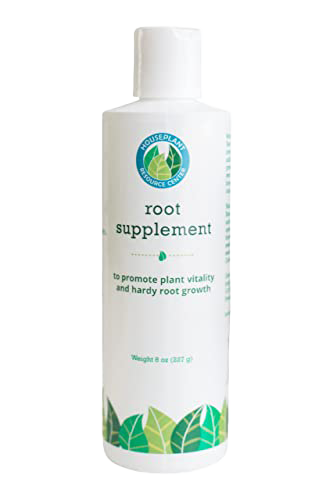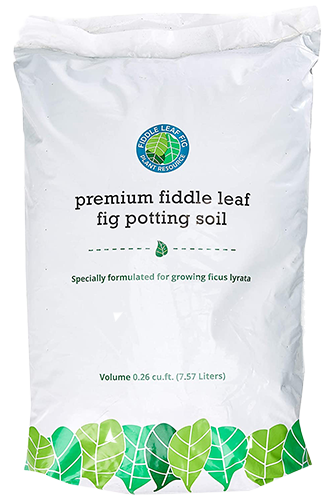How do you grow the tallest, healthiest, most beautiful fiddle leaf fig possible? In this fiddle leaf tree care guide, we’ll explain how to take the best care of your ficus lyrata so your tree will grow tall and gorgeous with lots of big green leaves!
Fiddle Leaf Tree Care
The most important thing with fiddle leaf tree care is to remember that you’re trying to grow a plant that evolved in the tropical rainforests of Western Africa. So, the closer you can replicate those conditions, the happier your tree will be!
Take your plant propagation to the next level with our exclusive Notching Bundle, the essential tool for fostering healthier growth and lush foliage in your plants! https://amzn.to/463xe6W
Lighting and Position
Fiddles love lots of bright sunlight. Most fiddles grown as houseplants are not acclimated to full sun like wild fiddle leaf trees are, so they’ll do best with plenty of indirect sunlight for at least 8 hours per day.
Place your fiddle in an east-facing window where it will get some direct sun in the morning and lots of bright but indirect sunlight throughout the day.
You can also place your tree near a south- or west-facing window, but make sure to move it back far enough or use sheer curtains to filter the light so the sun’s rays never fall directly on the leaves.
A north-facing window probably won’t provide enough light for your fiddle leaf tree to thrive. But if that’s your only option, you can supplement with a full-spectrum grow light.
Side note: You can acclimate your fiddle to full sun, which is actually really good for it! This will also open up your placement options. Learn more about that here.
Temperature & Humidity
Fiddles like warm, humid conditions. Make sure to keep temperatures between 65-85 degrees Fahrenheit, and don’t let them drop below 60 or your leaves might droop or even freeze.
On that note, make sure to keep your fiddle far from drafts, heaters, fireplaces, and AC/heating vents that can freeze, scorch, or dry out the leaves.
Though humidity levels in the rainforest can easily reach 60 or 70%, that isn’t feasible—or recommended—for indoor spaces because such high humidity can encourage mold growth. Your fiddle will do well with humidity levels around 50% if you can manage, and 40% at the lowest.
If you live in an arid area or use a lot of indoor climate control, you may want to consider setting up a humidifier near your tree to raise the ambient humidity and keep your leaves supple. You can place younger fiddles and dwarf varieties on a humidity tray, which you can buy online or at garden centers. You can also make a DIY version by filling a shallow tray with water and pebbles and placing the whole pot on top.
Placing your fiddle near other plants can also help, because plants will raise the ambient humidity with their respiration, and they’ll all benefit! Kitchens and bathrooms also tend to have higher humidity levels than other rooms in a house, so those can be good places for your fiddle if the light conditions are good.
Caring for Fiddle Leaf Trees in Winter
Since fiddles like warm, moist conditions, caring for them can be more challenging in the winter when it’s cold and dry.
In the winter, make sure your fiddle’s window is weather-sealed and not drafty. Avoid placing your fiddle near a heating vent that will start blasting hot, dry air at your plant as the weather gets colder. During the winter, you will almost certainly need to raise the humidity levels using one of the techniques we mentioned above in order to keep the leaves happy.
Water
Fiddles like consistently moist—but not soaked—soil.
We highly recommend keeping a close eye on your tree’s soil conditions and taking cues from your plant to know when it needs a drink rather than watering on a set schedule.
As a general rule, you should water when the top 2-3 inches of soil feel dry to the touch or when a moisture meter reads 3-4. The finger test can work if your soil’s well-aerated, but we like using a moisture meter because it gives you a better picture of what’s going on deeper in the pot. After all, if your pot or soil aren’t draining well, it’s possible for the top layer of soil to be dried out while the lower layers are still soggy!
Soil Conditions
It’s important to plant your tree in a light, chunky soil that drains quickly. Cactus soil can work well, or sometimes indoor potting mix with perlite and orchid bark mixed in will do.
We recommend our Premium Fiddle Leaf Fig Potting Soil because it perfectly balances drainage and moisture retention. It’s also highly nutritious, thanks to the inclusion of organic green compost. This soil also has a neutral pH level, which increases the bioavailability of nutrients for your fiddle.
Get Premium Fiddle Leaf Fig Soil on Amazon!
Make sure to keep your soil well-aerated with lots of air pockets around the roots. If you notice the soil getting hard and not readily absorbing water, consider repotting your tree into fresh soil.
Fertilizer for Fiddle Leaf Fig Trees
Growing and producing lots of those big beautiful leaves requires a lot of nutrients!
In nature, fiddle leaf trees get all the nutrients they need from their soil because organic matter is constantly breaking down and infusing the ground with nutrients. However, a fiddle growing in a pot can easily use up all the available nutrients within a few months.
During the spring and summer when your fiddle is most likely to be actively growing, fertilize regularly with a diluted liquid fertilizer. Look for an N-P-K ratio of 3-1-2 (this indicates the percentage of nitrogen, phosphorus, and potassium).
We recommend Fiddle Leaf Fig Food, which is specifically formulated for fiddles and other ficus varieties. It has an N-P-K ratio of 3-1-2 and is gentle enough to use with every watering, so you don’t have to worry about remembering a fertilization schedule!
Get Fiddle Leaf Fig Food on Amazon!
Pruning Fiddle Leaf Trees
You will probably need to prune your fiddle leaf tree from time to time, either to remove dead or diseased material or to shape your tree.
If you notice dead or damaged leaves, make sure to remove those so the tree can redirect energy toward healthy new growth.
If your tree is getting tall and you want to cultivate that iconic lollipop shape you see all over Instagram, you can start pruning the lower leaves to create this silhouette. (Notching can also encourage your tree to branch where you want it to.) That’s right, that lovely shape doesn’t come naturally!
When you prune your fiddle, make sure to use sterilized shears so you don’t spread bacteria or other harmful pathogens. The tree’s sap is also a skin irritant and can damage floors and furniture, so it’s a good idea to wear gloves and put down a drop cloth or use a towel to catch the sap.
Spring and summer are the best times to prune because your tree will probably be actively growing and more able to recover from the procedure. Also, make sure not to remove more than 10% of the leaves or branches at once to avoid sending your tree into shock. If you want to remove more, wait a week or two between sessions.
How to Propagate a Fiddle Leaf Tree
Propagating fiddle leaf trees can be fun and is a great way to clone your favorite plant!
The best way to do this is through stem cuttings or air layering. Here’s how!
Stem Cuttings
Find a young, healthy branch with at least one node (which will look like a subtle thickening of the stem between leaves). This is crucial because without a node, your cutting won’t grow into a mature fiddle that grows new branches.
Using sterilized shears, make your cut just below the node so that the node is included, along with at least one or two healthy leaves.
Place your cutting in a clean, clear glass container of purified water with a little Propagation Promoter (to help the cutting take root and prevent infection). Keep the water topped off and change it every week. Within a month or two, you should start to see roots forming. Once those roots are at least an inch long, you can plant the cutting in soil and care for it like a mature fiddle leaf tree!
Air Layering
Air layering is the process of growing new roots in the area you intend to propagate before you actually cut it off the mother tree.
To do this, you’ll need shears or a knife, sphagnum moss, plastic wrap, twist ties or string, and Propagation Promoter.
To do this, locate a fairly young branch with a few healthy leaves and a node nearby. Using clean shears or a knife, make a small cut in the stem near the node, no more than ⅓ of the way through the stem. Dab the wound with a little Propagation Promoter on a cotton ball.
Then wet a handful or two of moss and squeeze it out so it’s moist but not dripping wet. Wrap the moss around the wound, and then wrap plastic wrap around the moss. Secure the bundle of moss with twist ties or string, but not too tightly.
Every few days, rewet the moss. Within a few months, you should start to see roots growing around the cut. When the roots are an inch or longer, use clean shears to cut the whole section off just below the roots and plant it in soil.
Note: You’ll probably have the best results if you propagate in the spring!
Potting and Repotting Fiddle Leaf Fig Trees
Fiddle leaf fig trees grow fairly quickly, so plan on repotting your plant every year or so before it outgrows its pot. This will also refresh the soil and prevent it from becoming too compacted.
When potting—or repotting—a fiddle, choose a pot with drainage holes that’s about 2-3 inches larger than the root ball. And make sure it’s clean!
Unpot your fiddle by tipping the plant on its side and carefully coaxing it out of the pot. Use a trowel or a knife to pry it out if necessary, but NEVER put it up by the trunk.
Add a few inches of high-quality soil to the bottom of the pot, then place your tree upright inside. Fill in the sides with more soil, leaving a few inches of headroom at the top. Water thoroughly, then add more soil to the top to compensate for settling.
Avoid fertilizing for a month or two after potting to avoid burning the sensitive roots. The fresh soil should have enough nutrients that your fiddle won’t need the extra nutrition for at least a month or two anyway!
Common Problems With Fiddle Leaf Figs
Despite your best efforts, your fiddle leaf fig can sometimes develop issues!
Here are some common problems and signs to watch for, and what to do when you see them. Remember, it’s important to treat problems early before they become major threats to your plant. Don’t wait!
Pests
If you notice small brown or red dots (and you’ve ruled out edema), you might have an insect problem!
Fiddles are susceptible to scale, mealybugs, spider mites, and fungus gnats.
Here’s how to get rid of these pests and restore your fiddle to full health.
Brown Spots on Leaves
Brown spots can mean a few different things.
Crispy, light-brown spots can mean your fiddle is underwatered. Give it a good drink and remove the damaged leaves! (Read more about saving a dried-out fiddle here.)
Soft, dark-brown spots on the lower leaves can indicate overwatering or even root rot. Make sure your pot and soil are draining correctly, and if they aren’t, repot! Make sure your tree is getting plenty of light as well. Ease up on the water and use our Root Supplement when you do water to protect the roots from infection. If the spots get worse, repot the tree and prune off the rotting roots. Be sure to remove the damaged leaves as well.
Medium-brown spots all over the tree can indicate a bacterial infection. It can be hard to tell between this and root rot, but luckily, the treatment for these two is the same: repot, ease up on the water, remove the damaged leaves, and provide plenty of light.
Yellow Leaves
Yellow leaves usually indicate too much water/insufficent light or a nutrient deficiency. If your tree’s soil is still wet long after you watered or isn’t in a bright enough area, make adjustments. If the light and water conditions seem to be fine, think about the last time you fertilized. If it’s been a long time, you may want to do that soon!
Dropping Leaves
Dropped leaves can have lots of different causes. If you recently moved or repotted your tree, it’s normal for it to droop and even drop a few leaves due to shock, but it should recover in about a week.
It’s also normal for fiddles to occasionally drop an older lower leaf simply because they’re done with it. No cause for alarm!
Here’s more about why fiddles might drop leaves and how to treat it.
Fiddle Leaf Tree Maintenance
Here are a few more tips on maintaining your fiddle leaf fig tree!
Regular Leaf Cleaning
Once a week, use a soft cloth to dust your leaves. Use water with a little gentle, detergent-free soap if your leaves are especially dirty.
Our Leaf Shine spray can also help keep your leaves clean, shiny, and healthy!
Rotate Regularly
When you water your tree, give it a quarter turn or so to allow all sides to receive sufficient light. This will help it grow evenly!
How to Encourage Bushy Growth
The best way to get a fiddle to grow lots of leaves is plenty of light and fertilizer.
Put your tree in the brightest spot in your house (but watch out for direct sun) and make sure to fertilize regularly during the growing season.
How to Prevent Your Fiddle Leaf Tree From Leaning
Make sure to rotate your tree to encourage it to grow evenly, and provide lots of light in general so it will grow a strong, supportive trunk.
If you absolutely have to, you can stake a leaning or flimsy fiddle, but make sure to wiggle it regularly to encourage stronger growth so it can eventually stand on its own! (Yes, you read that right. Here’s how to do this.)
Types of Fiddle Leaf Fig Tree
Fiddle leaf figs come in a few different varieties. If you’re a big fiddle leaf fig fan, check them out!
Ficus Lyrata “Bambino”
This is a mini fiddle that only grows to about 5 feet indoors. It also has smaller, rounder leaves. This is a great option if you love fiddles but don’t have the space for a huge tree!
Ficus Lyrata “Compacta”
This dwarf variety is even smaller than the bambino, only growing to 3 feet tall! Its small, rounded leaves are also adorable.
Here’s how to care for (and tell the difference between) compacta and bambino!
Ficus Lyrata “Variegata”
The variegated fiddle is a full-size ficus variety that looks like just a standard ficus lyrata but with stunning green, white, and cream leaves!
This variety is tricky to find and even trickier to care for, but if you love fiddles, it might be worth a shot!
Here’s how to find and care for a variegated fiddle leaf fig.
FAQ Fiddle Leaf Tree Care
You’ve got questions, we’ve got answers!
FAQ: Can you revive a dying fiddle leaf fig?
It depends on why your fiddle is dying, and the answer is…maybe. Use the guide above and the resources on this site to diagnose and treat the issue. If you catch the problem early enough, you should be able to save your tree!
However, as long as the stem is still alive, there’s hope (if you’re up to it). Read this amazing story about a reader who regrew her fiddle from a naked stick!
FAQ: Can a fiddle leaf tree outgrow your house?
A fiddle will grow as tall as it possibly can, reaching your ceiling and even bending over if it needs to.
The good news is, you can prune your tree to keep its size under control. If it gets too tall or too imbalanced, use sharp, clean shears to cut it back to size.
Give Fiddles a Try!
This may seem like a lot, but fiddle leaf fig trees are a joy to care for, and once you get into a groove with your care routine and really understand what makes your fiddle happy, care can be a breeze.
We’ve got everything you need to make caring for your fiddle fun and simple!

